Phenological Development, Thermal Requirement, and Quality of ‘BRS Núbia’ (Vitis vinifera L. x Vitis labrusca L.) Grapes on Different Rootstocks
Abstract
1. Introduction
2. Materials and Methods
2.1. Experimental Site Location
2.2. Experimental Site Setup and Management
2.3. Experimental Design and Treatments
2.4. Evaluated Variables
2.4.1. Phenological Stages
2.4.2. Physiological Maturation and Physicochemical Quality of ‘BRS Núbia’ Grape Must
2.4.3. Thermal Requirement and Growing Degree Days
- GDD: Accumulated growing degree days;
- Tm: Daily mean temperature (°C).
2.5. Statistical Analyses
3. Results and Discussion
3.1. Duration of Phenological Stages and Thermal Requirement of ‘BRS Núbia’ Grapevine
3.2. Evolution of ‘BRS Núbia’ Grape Ripening
3.3. Principal Component Analysis (PCA)
4. Conclusions
Author Contributions
Funding
Data Availability Statement
Conflicts of Interest
References
- Candar, S.; Uysal, T.; Ayaz, A.; Akdemir, U.; Korkutal, İ.; Bahar, E. Viticulture tradition in Turkey. Vitic. Stud. (VIS) 2021, 1, 39–54. [Google Scholar] [CrossRef]
- Monteiro, A.I.; Malheiro, A.C.; Bacelar, E.A. Morphology, physiology and analysis techniques of grapevine bud fruitfulness: A review. Agriculture 2021, 11, 127. [Google Scholar] [CrossRef]
- Palliotti, A.; Tombesi, S.; Silvestroni, O.; Lanari, V.; Gatti, M.; Poni, S. Changes in vineyard establishment and canopy management urged by earlier climate-related grape ripening: A review. Sci. Hortic. 2014, 178, 43–54. [Google Scholar] [CrossRef]
- Wilson, T.G.; Kustas, W.P.; Alfieri, J.G.; Anderson, M.C.; Gao, F.; Prueger, J.H.; Alstad, K.P. Relationships between soil water content, evapotranspiration, and irrigation measurements in a California drip-irrigated Pinot noir vineyard. Agric. Water Manag. 2020, 237, 106186. [Google Scholar] [CrossRef]
- Evangelista, T.Y.L.; Pereira, G.A. Climatic potential, phenology, and thermal needs of vines grown at different times in the semi-arid region. Bragantia 2024, 84, e20240189. [Google Scholar]
- Zombardo, A.; Mica, E.; Puccioni, S.; Perria, R.; Valentini, P.; Mattii, G.B.; Storchi, P. Berry quality of grapevine under water stress as affected by rootstock–scion interactions through gene expression regulation. Agronomy 2020, 10, 680. [Google Scholar] [CrossRef]
- Ranade, Y.; Pathak, P.; Chandrashekar, M.; Saha, S. Diversity analysis of culturable epiphytic microbial consortia of table grape berry surface. Food Biotechnol. 2023, 37, 54–73. [Google Scholar] [CrossRef]
- Sabra, A.; Netticadan, T.; Wijekoon, C. Grape bioactive molecules, and the potential health benefits in reducing the risk of heart diseases. Food Chem. X 2021, 12, 100149. [Google Scholar] [CrossRef]
- Abi Rached, R.; Perra, M.; Manca, M.L.; Rajha, H.N.; Louka, N.; Maroun, R.G.; Manconi, M. Exploring the efficacy and industrial potential of polyphenol products from grapes and their by-products. Sustain. Chem. Pharm. 2024, 42, 101805. [Google Scholar] [CrossRef]
- Liu, X.; Hu, K.K.; Haritos, V.S. Enzymatic production of cello-oligosaccharides with potential human prebiotic activity and release of polyphenols from grape marc. Food Chem. 2024, 435, 137562. [Google Scholar] [CrossRef]
- Nirmal, N.; Mahale, K.R.; Rathod, N.B.; Siddiqui, S.A.; Dhar, B.K. Winery waste: A sustainable approach for bioactive compound extraction and various industrial applications. Process Saf. Environ. Prot. 2025, 193, 760–771. [Google Scholar] [CrossRef]
- Alston, J.M.; Sambucci, O. Grapes in the world economy. In The Grape Genome; Springer: Cham, Switzerland, 2019; pp. 1–24. [Google Scholar]
- Vukovic, D.B.; Maiti, M.; Vujko, A.; Shams, R. Residents’ perceptions of wine tourism on the rural destinations development. Br. Food J. 2020, 122, 2739–2753. [Google Scholar] [CrossRef]
- García-Navarro, F.J.; Jiménez-Ballesta, R.; Perales, J.A.L.; Perez, C.; Amorós, J.A.; Bravo, S. Sustainable Viticulture in the Valdepeñas Protected Designation of Origin: From Soil Quality to Management in Vitis vinifera. Sustainability 2023, 15, 9339. [Google Scholar] [CrossRef]
- Straffelini, E.; Carrillo, N.; Schilardi, C.; Aguilera, R.; Orrego, M.J.E.; Tarolli, P. Viticulture in Argentina under extreme weather scenarios: Actual challenges, future perspectives. Geogr. Sustain. 2023, 4, 161–169. [Google Scholar] [CrossRef]
- Myga-Piątek, U.; Rahmonov, O. Winery regions as the oldest cultural landscapes: Remnants, signs, and metamorphoses. Misc. Geogr. Reg. Stud. Dev. 2018, 22, 69–80. [Google Scholar] [CrossRef]
- Gutiérrez Gamboa, G.; Pszczólkowski, P.; Fourment, M. Opening Remarks and General Overview of the Current Scientific Scenario of Latin American Vitiviniculture: A Critical View. In Latin American Viticulture Adaptation to Climate Change: Perspectives and Challenges of Viticulture Facing up Global Warming; Springer: Cham, Switzerland, 2024; pp. 1–18. [Google Scholar]
- OIV. The International Organisation of Vine and Wine. Statistics. 2023. Available online: https://www.oiv.int/index.php/what-we-do/statistics (accessed on 15 January 2025).
- IBGE. Instituto Brasileiro de Geografia e Estatística. In Levantamento Sistemático da Produção Agrícola (LSPA); IBGE: Rio de Janeiro, Brazil, 2023. Available online: https://sidra.ibge.gov.br/pesquisa/lspa/tabelas (accessed on 18 April 2024).
- Dinis, L.T.; Bernardo, S.; Yang, C.; Fraga, H.; Malheiro, A.C.; Moutinho-Pereira, J.; Santos, J.A. Mediterranean viticulture in the context of climate change. Ciênc. Téc. Vitivinoícol. 2022, 37, 139–158. [Google Scholar] [CrossRef]
- Aydin, D.; Coskun, O.F. Comparison of edta-enhanced phytoextraction strategies with Nasturtium officinale (Watercress) on an artificially arsenic contaminated water. Pak. J. Bot. 2013, 45, 1423–1429. [Google Scholar]
- Coşkun, Ö.F. Association Mapping for Drought Tolerance in Watermelons (Citrullus lanatus L.). Horticulturae 2025, 11, 193. [Google Scholar] [CrossRef]
- Dry, I.B.; Davies, C.; Dunlevy, J.D.; Smith, H.M.; Thomas, M.R.; Walker, A.R.; Walker, R.R.; Clingeleffer, P.R. Development of new wine-, dried-and tablegrape scions and rootstocks for Australian viticulture: Past, present and future. Aust. J. Grape Wine Res. 2022, 28, 177–195. [Google Scholar] [CrossRef]
- Massano, L.; Fosser, G.; Gaetani, M.; Bois, B. Assessment of climate impact on grape productivity: A new application for bioclimatic indices in Italy. Sci. Total Environ. 2023, 905, 167134. [Google Scholar] [CrossRef]
- Kabato, W.; Getnet, G.T.; Sinore, T.; Nemeth, A.; Molnár, Z. Towards climate-smart agriculture: Strategies for sustainable agricultural production, food security, and greenhouse gas reduction. Agronomy 2025, 15, 565. [Google Scholar] [CrossRef]
- Leonel, S.; Roberto, S.R.; da Silva, S.R. Orchard Management Under Climate Change. Horticulturae 2025, 11, 98. [Google Scholar] [CrossRef]
- Leão, P.C.S.; Nascimento, J.H.B.; Moraes, D.S.; Souza, E.R. Yield components of the new seedless table grape ‘BRS Ísis’ as affected by the rootstock under semi-arid tropical conditions. Sci. Hortic. 2020, 263, 109114. [Google Scholar] [CrossRef]
- Domingues Neto, F.J.; Tecchio, M.A.; Borges, C.V.; Rodrigues, J.D.; Ono, E.O.; Lima, G.P.P.; Leonel, M. Yield Performance and Quality Assessment of Brazilian Hybrid Grapes Influenced by Rootstocks and Training Systems. Horticulturae 2024, 10, 909. [Google Scholar] [CrossRef]
- Callili, D.; Tecchio, M.A.; Sánchez, C.A.P.C.; Neto, F.J.D.; Bonfim, F.P.G.; de Souza Silva, M.; Campos, O.P. Table grape ‘BRS Vitória’yield performance, vigor, and quality as influenced by rootstocks in a subtropical region. Aust. J. Crop Sci. 2025, 119, 284–291. [Google Scholar]
- Gonçalves, B.; Aires, A.; Oliveira, I.; Afonso, S.; Morais, M.C.; Correia, S.; Silva, A.P. Sweet cherry. In Temperate Fruits; Apple Academic Press: Cambridge, MA, USA, 2021; pp. 333–415. [Google Scholar]
- Sánchez, C.A.P.C.; Tecchio, M.A.; Callili, D.; da Silva, M.J.R.; Basílio, L.S.P.; Leonel, S.; Alonso, J.C.; Lima, G.P.P. Productivity and physicochemical properties of the BRS Isis grape on various rootstocks under subtropical climatic conditions. Agriculture 2023, 13, 2113. [Google Scholar] [CrossRef]
- Leão, P.C.S.; Carvalho, J.N. Tropical Viticulture in Brazil: São Francisco Valley as an Important Supplier of Table Grapes to the World Market. In Latin American Viticulture Adaptation to Climate Change: Perspectives and Challenges of Viticulture Facing up Global Warming; Springer International Publishing: Cham, Switzerland, 2024; pp. 47–59. [Google Scholar]
- Campos, L.F.C.; Alves, J., Jr.; Campos, C.M.d.A.; Casaroli, D.; Evangelista, A.W.P.; Seleguini, A. Sistema radicular do porta-enxerto IAC 572 ‘JALES’ sob Niágara rosada nas condições do Cerrado Goiano. Irriga 2017, 22, 723–734. [Google Scholar] [CrossRef]
- Tecchio, M.A.; Hernandes, J.L.; Paioli Pires, E.J.; Terra, M.M.; Moura, M.F. Cultivo da videira para mesa, vinho e suco. In Cultivo de Fruteiras Clima Temperado em Regiões Subtropicais e Tropicais, 2nd ed.; Pio, R., Ed.; UFLA: Lavras, Brazil, 2018; pp. 512–584. [Google Scholar]
- Viana, A.P.; Rodrigues, D.L.; Santos, E.A. Porta-enxerto, cultivares de mesa e de vinho. In Uva: Do Plantio à Colheita; Motoike, S., Borém, A., Eds.; Editora UFV: Viçosa, Brazil, 2018; pp. 49–60. [Google Scholar]
- Tecchio, M.A.; Moura, M.F.; Teixeira, L.A.J.; Pires, E.J.; Leonel, S. Influence of rootstocks and pruning times on yield and nutrients content and extraction in ‘Niagara Rosada’ grapevine. Pesqui. Agropecu. Bras. 2014, 49, 340–348. [Google Scholar] [CrossRef]
- Callili, D.; Sanchez, C.A.P.C.; Campos, O.P.; Carneiro, D.C.d.S.; ScudelettI, A.C.B.; Tecchio, M.A. Phenology, thermal demand, and maturation development of the ‘BRS Vitória’ grape cultivated on different rootstocks in subtropical conditions. Rev. Bras. Frutic. 2023, 45, e-999. [Google Scholar] [CrossRef]
- Leão, P.C.d.S.; Lima, M.A.C.; de Cultivar, B.R.S. Núbia: Produtividade e Qualidade da Uva no Submédio do Vale do São Francisco. Circular Técnica n 172; Embrapa Semiárido: Petrolina, Brazil, 2017; pp. 1–4. [Google Scholar]
- Ahmed, S.; Roberto, S.R.; Shahab, M.; Colombo, R.C.; Silvestre, J.P.; Koyama, R.; Souza, R.T. Proposal of double-cropping system for ‘BRS Isis’ seedless grape grown in subtropical area. Sci. Hortic. 2019, 251, 118–126. [Google Scholar] [CrossRef]
- Salama, A.M.; Ezzat, A.; El-Ramady, H.; Alam-Eldein, S.M.; Okba, S.K.; Elmenofy, H.M.; Holb, I.J. Temperate fruit trees under climate change: Challenges for dormancy and chilling requirements in warm winter regions. Horticulturae 2021, 7, 86. [Google Scholar] [CrossRef]
- Yin, Y.; Deng, H.; Wu, S. Spatial-temporal variations in the thermal growing degree-days and season under climate warming in China during 1960–2011. Int. J. Biometeorol. 2019, 63, 649–658. [Google Scholar] [CrossRef]
- Charalampopoulos, I.; Polychroni, I.; Psomiadis, E.; Nastos, P. Spatiotemporal estimation of the olive and vine cultivations’ Growing Degree days in the Balkans region. Atmosphere 2021, 12, 148. [Google Scholar] [CrossRef]
- Embrapa; Empresa Brasileira de Pesquisa Agropecuária. Sistema Brasileiro de Classificação de Solos; Centro Nacional de Pesquisa de Solos: Rio de Janeiro, Brazil, 2018. [Google Scholar]
- Tecchio, M.A.; Teixeira, L.A.J.; Terra, M.M.; Paioli-Pires, E.J.; Hernandes, J.L. Uvas comuns para mesa e vinho (Vits lambusca). In Boletim 100: Recomendações de Adubação e Calagem Para o Estado de São Paulo, 2nd ed.; Cantarella, H., Quaggio, J.A., Mattos, D., Jr., Boaretto, R.M., Van Raij, B., Eds.; Instituto Agronômico: Campinas, Brazil, 2022; pp. 303–308. [Google Scholar]
- Eichhorn, K.W.; Lorenz, D.H. Phaenologische Entwicklungsstadien der Rebe. Eur. Mediterr. Plant Prot. Organ. 1984, 14, 295–298. [Google Scholar]
- Coombe, B.G. Growth Stages of the Grapevine: Adoption of a system for identifying grapevine growth stages. Aust. J. Grape Wine Res. 1995, 1, 104–110. [Google Scholar] [CrossRef]
- AOAC. Association of Official Analytical Chemists. Official Methods of Analysis of AOAC International, 18th ed.; AOAC: Washington, DC, USA, 2005. [Google Scholar]
- Instituto Adolfo Lutz. Métodos Físico-Químicos Para Análise de Alimentos; Intituto Adolfo Lutz: São Paulo, Brazil, 2008; 1020p.
- Winkler, A.J. Viticultura; Companhia Editorial Continental: México City, México, 1965. [Google Scholar]
- Villa Nova, N.A.; Pedro Júnior, M.J.; Pereira, A.R.; Ometto, J.C. Estimativa de graus-dia acumulados acima de qualquer temperatura base em função das temperaturas máxima e mínima. Ciênc. Terra 1972, 30, 1–8. [Google Scholar]
- Pedro Júnior, M.J.; Sentelhas, P.C.; Pommer, C.V. Determinação da temperatura-base, graus-dia e índice biometeorológico para a videira ‘Niagara Rosada’. Rev. Bras. Agrometeorol. 1994, 2, 51–56. [Google Scholar]
- Ferreira, D.F. Sisvar: A computer statistical analysis system. Ciênc. Agrotecnol. 2011, 35, 1039–1042. [Google Scholar] [CrossRef]
- Cataldo, E.; Eichmeier, A.; Mattii, G.B. Effects of Global Warming on Grapevine Berries Phenolic Compounds—A Review. Agronomy 2023, 13, 2192. [Google Scholar] [CrossRef]
- Camargo-Alvarez, H.; Salazar-Gutiérrez, M.; Keller, M.; Hoogenboom, G. Modeling the effect of temperature on bud dormancy of grapevines. Agric. For. Meteorol. 2020, 280, 15. [Google Scholar] [CrossRef]
- Malinovski, L.I.; Pandolfo, C.; Campos, C.G.C.; de Lima, M.; da Silva, A.L.; Vieira, H.J. Clima: Viticultura de elevada altitude do estado de Santa Catarina. In A Cultura da Videira: Viticultura de Altitude; Rufato, L., Filho, J.L.M., Brighenti, A.F., Bogo, A., Kretzsschmar, A.A., Eds.; UDESC: Florianópolis, Brazil, 2021; pp. 27–47. [Google Scholar]
- Mas, I.; de la Fuente, J.L.; Ruiz-Bermejo, M. Temperature effect on aqueous NH4CN polymerization: Relationship between kinetic behaviour and structural properties. Eur. Polym. J. 2020, 132, 109719. [Google Scholar] [CrossRef]
- Rességuier, L.; Mary, S.; Le Roux, R.; Petitjean, T.; Quénol, H.; Van Leeuwen, C. Temperature variability at local scale in the Bordeaux area. Relations with environmental factors and impact on vine phenology. Front. Plant Sci. 2020, 11, 515. [Google Scholar] [CrossRef] [PubMed]
- Schrader, J.A.; Cochran, D.R.; Domoto, P.A.; Nonnecke, G.R. Phenology and winter hardiness of cold-climate grape cultivars and advanced selections in Iowa climate. HortTechnology 2019, 29, 906–922. [Google Scholar] [CrossRef]
- Anzanello, R.; Fogaça, C.M.; Sartori, G.B.D. Induction and overcoming of dormancy of grapevine buds in response to thermal variations in the winter period. Cienc. Rural. 2021, 51, e20200887. [Google Scholar] [CrossRef]
- Velappan, Y.; Chabikwa, T.G.; Considine, J.A.; Agudelo-Romero, P.; Foyer, C.H.; Signorelli, S.; Considine, M.J. The bud dormancy disconnect: Latent buds of grapevine are dormant during summer despite a high metabolic rate. J. Exp. Bot. 2022, 73, 2061–2076. [Google Scholar] [CrossRef]
- Velappan, Y.; Considine, J.A.; Signorelli, S.; Considine, M.J. Contrasting seasonal dynamics of dormancy, respiratory metabolism and cell cycle state in grapevine buds of a subtropical and Mediterranean climate. Food Energy Secur. 2023, 12, e431. [Google Scholar] [CrossRef]
- Liu, M.; Zhao, Y.; Fan, P.; Kong, J.; Wang, Y.; Xu, X.; Dai, Z. Grapevine plantlets respond to different monochromatic lights by tuning photosynthesis and carbon allocation. Hortic. Res. 2023, 10, uhad160. [Google Scholar] [CrossRef]
- Domingues Neto, F.J.; Pimentel Junior, A.; Modesto, L.R.; Moura, M.F.; Putti, F.F.; Boaro, C.S.F.; Ono, E.O.; Rodrigues, J.D.; Tecchio, M.A. Photosynthesis, Biochemical and Yield Performance of Grapevine Hybrids in Two Rootstock and Trellis Height. Horticulturae 2023, 9, 596. [Google Scholar] [CrossRef]
- Mirás-Avalos, J.M.; Araujo, E.S. Optimization of vineyard water management: Challenges, strategies, and perspectives. Water 2021, 13, 746. [Google Scholar] [CrossRef]
- Rogiers, S.Y.; Greer, D.H.; Liu, Y.; Baby, T.; Xiao, Z. Impact of climate change on grape berry ripening: An assessment of adaptation strategies for the Australian vineyard. Front. Plant Sci. 2022, 13, 1094633. [Google Scholar] [CrossRef]
- Gorrasi, G.; Bugatti, V.; Vertuccio, L.; Vittoria, V.; Pace, B.; Cefola, M.; Clarizia, G. Active packaging for table grapes: Evaluation of antimicrobial performances of packaging for shelf life of the grapes under thermal stress. Food Packag. Shelf Life 2020, 25, 100545. [Google Scholar] [CrossRef]
- Hazarika, T.K.; Marak, T. Salicylic acid and oxalic acid in enhancing the quality and extending the shelf life of grape cv. Thompson seedless. Food Sci. Technol. Int. 2022, 28, 463–475. [Google Scholar] [CrossRef]
- Maia, J.D.G.; Ritschel, P.; Camargo, U.A.; Souza, R.T.; Farjado, T.V.M.; Girardi, C.L. BRS Núbia Nova Cultivar de Uva de Mesa com Sementes e Coloração Preta Uniforme. Circular Técnica n 139., 1st ed.; Embrapa Uva e Vinho: Bento Gonçalves, Brazil, 2013; p. 12. [Google Scholar]
- Campos, L.; Vendruscolo, E.; Campos, C.; Teramoto, A.; Seleguini, A. Preliminary results on agronomic behavior of table grapes on different rootstocks in brazilian Cerrado conditions. Agric. Conspec. Sci. 2022, 87, 265–276. [Google Scholar]
- Chavarria, G.; Santos, H.P.; Mandelli, F.; Marodin, G.A.B.; Bergamaschi, H.; Cardoso, L.S. Caracterização fenológica e requerimento térmico da cultivar moscato giallo sob cobertura plástica. Rev. Bras. Frutic. 2009, 31, 119–126. [Google Scholar] [CrossRef]
- Blancquaert, E.H.; Oberholster, A.; Ricardo-da-Silva, J.M.; Deloire, A.J. Effects of abiotic factors on phenolic compounds in the grape berry—A review. S. Afr. J. Enol. Vitic. 2019, 40, 1. [Google Scholar] [CrossRef]
- Callili, D.; da Silva, M.J.R.; Sanchez, C.A.P.C.; Watanabe, C.Y.; Macedo, B.M.d.P.; Domingues Neto, F.J. Rootstock and potassium fertilization, in terms of phenology, thermal demand and chemical evolution, of berries on Niagara Rosada grapevine under subtropical conditions. Bragantia 2022, 81, e2022. [Google Scholar] [CrossRef]
- Bruna, E.D.; Back, Á.J. Comportamento da cultivar Niágara Rosada enxertada sobre diferentes porta-enxertos no sul de Santa Catarina, Brasil. Rev. Bras. Frutic. 2015, 37, 924–933. [Google Scholar] [CrossRef][Green Version]
- Tecchio, M.A.; da Silva, M.J.R.; Paiva, A.P.M.; Moura, M.F.; Terra, M.M.; Pires, E.J.P.; Leonel, S. Phenological, physicochemical, and productive characteristics of “Vênus” grapevine onto rootstocks. Pesqui. Agropecu. Bras. 2019, 54, e00335. [Google Scholar] [CrossRef]
- Grillakis, M.G.; Doupis, G.; Kapetanakis, E.; Goumenaki, E. Future shifts in the phenology of table grapes on Crete under a warming climate. Agric. For. Meteorol. 2022, 318, 108915. [Google Scholar] [CrossRef]
- Wurz, D.A.; Filho, J.L.M.; Rufato, L. Implantação do vinhedo. In A Cultura da Videira: Viticultura de Altitude; Rufato, L., Filho, J.L.M., Brighenti, A.F., Bogo, A., Kretzsschmar, A.A., Eds.; UDESC: Florianópolis, Brazil, 2021; pp. 159–180. [Google Scholar]
- Brasil. Ministério da Agricultura, Pecuária e Abastecimento. In Instrução Normativa Nº 1, de 1º de Fevereiro de 2002; Ministério da Agricultura, Pecuária e Abastecimento: Brasília, Brazil, 2002; p. 5.
- Brasil. Ministério da Agricultura, Pecuária e Abastecimento. In Instrução Normativa Nº 69, de 6 de Novembro de 2018; Ministério da Agricultura, Pecuária e Abastecimento: Brasília, Brazil, 2018; p. 25.
- Irimia, L.M.; Patriche, C.V.; Bucur, G.M.; Quénol, H.; Cotea, V.V. Spatial Distribution of Grapes Sugar Content and its Correlations with Climate Characteristics and Climate Suitability in the Huși (Romania) Wine Growing Region. Not. Bot. Horti Agrobot. 2015, 43, 250–258. [Google Scholar] [CrossRef]
- Drappier, J.; Thibon, C.; Rabot, A.; Geny-Denis, L. Relationship between wine composition and temperature: Impact on Bordeaux wine typicity in the context of global warming-Review. Crit. Rev. Food Sci. Nutr. 2019, 59, 14–30. [Google Scholar] [CrossRef] [PubMed]
- Batista-Silva, W.; Nascimento, V.L.; Medeiros, D.B.; Nunes-Nesi, A.; Ribeiro, D.M.; Zsögön, A.; Araújo, W.L. Modifications in organic acid profiles during fruit development and ripening: Correlation or causation? Front. Plant Sci. 2018, 9, 1689. [Google Scholar] [CrossRef]
- Mota, R.V.; Silva, C.P.C.; Favero, A.C.; Purgatto, E. Composição físico-química de uvas para vinho fino em ciclos de verão e inverno. Rev. Bras. Frutic. 2010, 32, 1127–1137. [Google Scholar] [CrossRef]
- Cardoso, K.S.; Neto, P.L.A.N. Caracterização fenológica de cultivares de videira de mesa sobre o porta-enxerto IAC 572 em Goiânia-GO. Ipê Agron. J. 2022, 6, 7011. [Google Scholar]
- Koyama, R.; Borges, W.F.S.; Colombo, R.C.; Hussain, I.; Souza, R.T.; Roberto, S.R. Phenology and yield of the hybrid seedless grape ‘BRS Melodia’ grown in an annual double cropping system in a subtropical area. Horticulturae 2020, 6, 3. [Google Scholar] [CrossRef]
- Santana, S.; Dos Santos, V.; Tecchio, M.; Pereira, L.; Nunes, A.; Almeida, H.; Pereira, G. Caracterização físico-química de uvas ‘BRS Vitória’ cultivadas em clima subtropical. Rev. Iberoam. Tecnol. Postcosecha 2023, 24, 150–163. [Google Scholar]
- Plantevin, M.; Merpault, Y.; Lecourt, J.; Destrac-Irvine, A.; Dijkstra, L.; van Leeuwen, C. Characterization of varietal effects on the acidity and pH of grape berries for selection of varieties better adapted to climate change. Front. Plant Sci. 2024, 15, 1439114. [Google Scholar] [CrossRef] [PubMed]
- Winkler, A.J.; Cook, J.A. General Viticulture, 4th ed.; University of California Press: Berkley, CA, USA, 1974. [Google Scholar]
- Silva, L.; Caldas, L.A.; Ribeiro, M.G.; Almeida, R.V. Obstáculos Epistemológicos no Ensino-Aprendizagem de Química Geral e Inorgânica no Ensino Superior: Resgate da definição ácido-base de Arrhenius e crítica ao ensino das “funções inorgânicas”. Quím. Nova Esc. 2014, 36, 261–268. [Google Scholar]
- Gambetta, G.A.; Manuck, C.M.; Drucker, S.T.; Shaghasi, T.; Fort, K.; Matthews, M.A.; Walker, M.A.; McElrone, A.J. The relationship between root hydraulics and scion vigour across Vitis rootstocks: What role do root aquaporins play? J. Exp. Bot. 2012, 63, 6445–6455. [Google Scholar] [CrossRef]
- García-Pastor, M.E.; Zapata, P.J.; Castillo, S.; Martínez-Romero, D.; Valero, D.; Serrano, M.; Guillén, F. Preharvest salicylate treatments enhance antioxidant compounds, color and crop yield in low pigmented-table grape cultivars and preserve quality traits during storage. Antioxidants 2020, 9, 832. [Google Scholar] [CrossRef]
- Navarro-Calderon, A.; Falagan, N.; Terry, L.A.; Alamar, M.C. Biomarkers of postharvest resilience: Unveiling the role of abscisic acid in table grapes during cold storage. Front. Plant Sci. 2023, 14, 1266807. [Google Scholar] [CrossRef] [PubMed]
- Chen, Y.; Fei, Y.; Howell, K.; Chen, D.; Clingeleffer, P.; Zhang, P. Rootstocks for grapevines now and into the future: Selection of rootstocks based on drought tolerance, soil nutrient availability, and soil pH. Aust. J. Grape Wine Res. 2024, 2024, 6704238. [Google Scholar] [CrossRef]
- Duchêne, E.; Huard, F.; Dumas, V.; Schneider, C.; Merdinoglu, D. The challenge of adapting grapevine varieties to climate change. Clim. Res. 2010, 41, 193–204. [Google Scholar] [CrossRef]
- Fraga, H.; Santos, J.A.; Moutinho-Pereira, J.; Carlos, C.; Silvestre, J.; Eiras-Dias, J.; Malheiro, A.C. Statistical modelling of grapevine phenology in Portuguese wine regions: Observed trends and climate change projections. J. Agric. Sci. 2016, 154, 795–811. [Google Scholar] [CrossRef]
- Van Leeuwen, C.; Destrac-Irvine, A.; Dubernet, M.; Duchêne, E.; Gowdy, M.; Marguerit, E.; Ollat, N. An update on the impact of climate change in viticulture and potential adaptations. Agronomy 2019, 9, 514. [Google Scholar] [CrossRef]
- Rafique, R.; Ahmad, T.; Ahmed, M.; Khan, M.A. Exploring key physiological attributes of grapevine cultivars under the influence of seasonal environmental variability. OENO One 2023, 57, 2. [Google Scholar] [CrossRef]
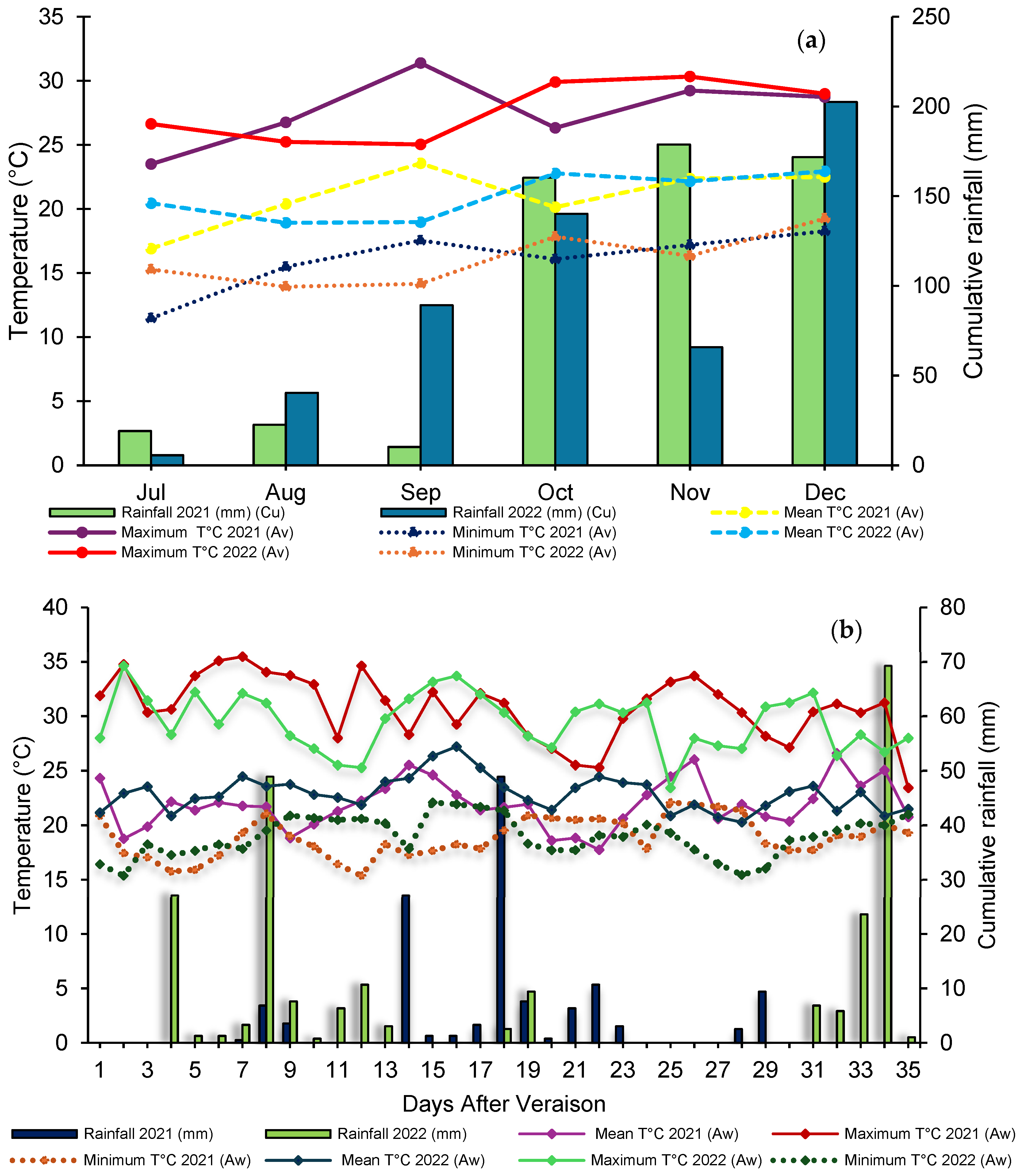
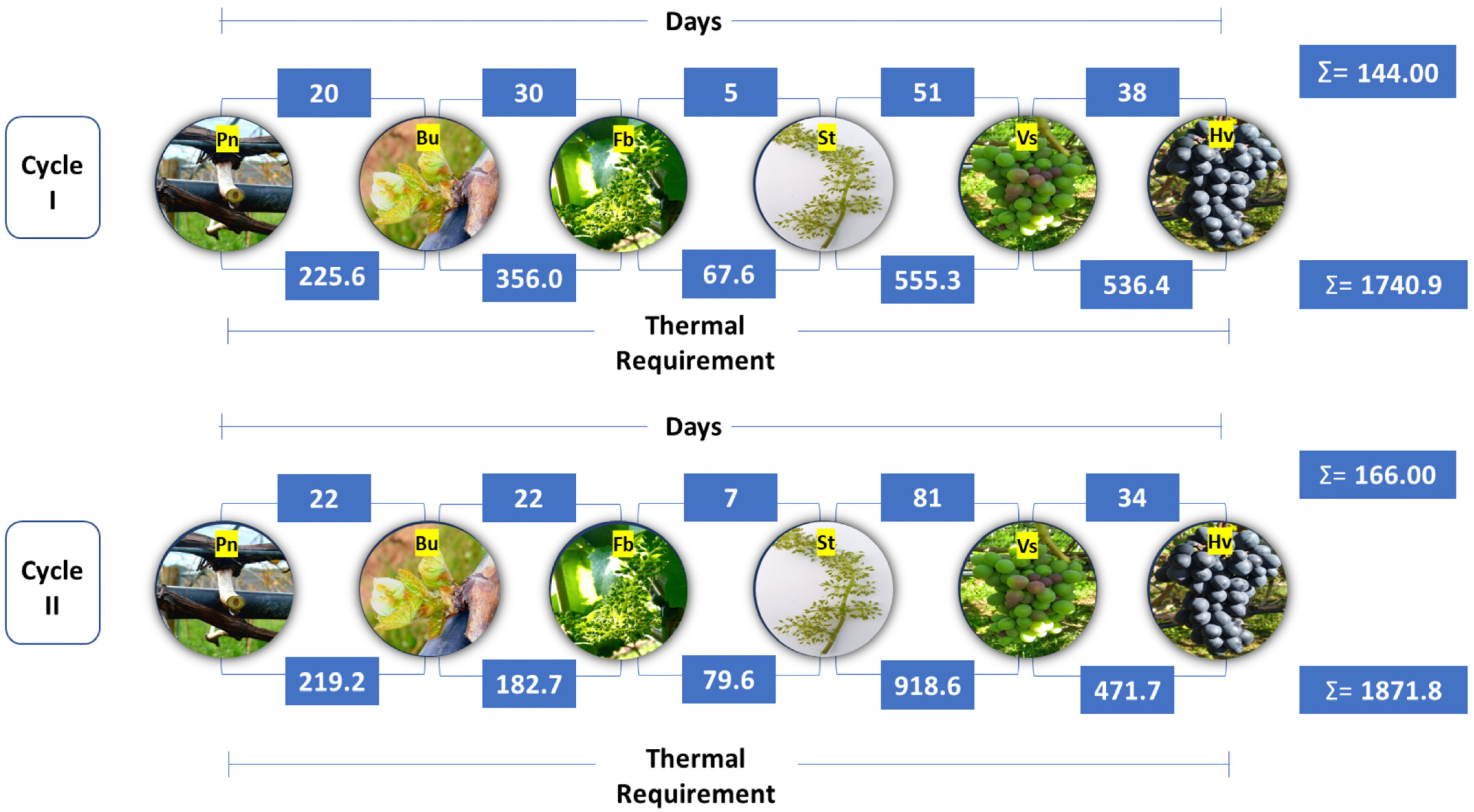
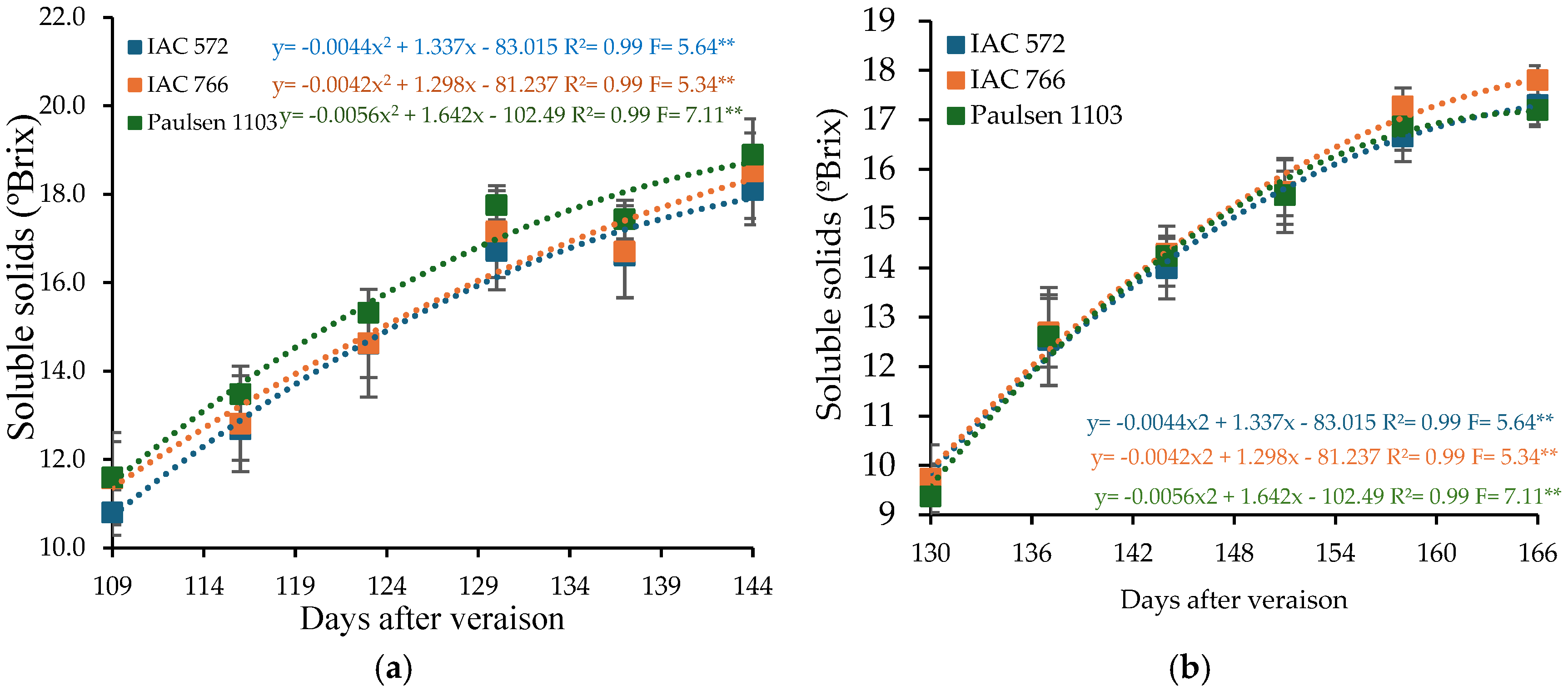
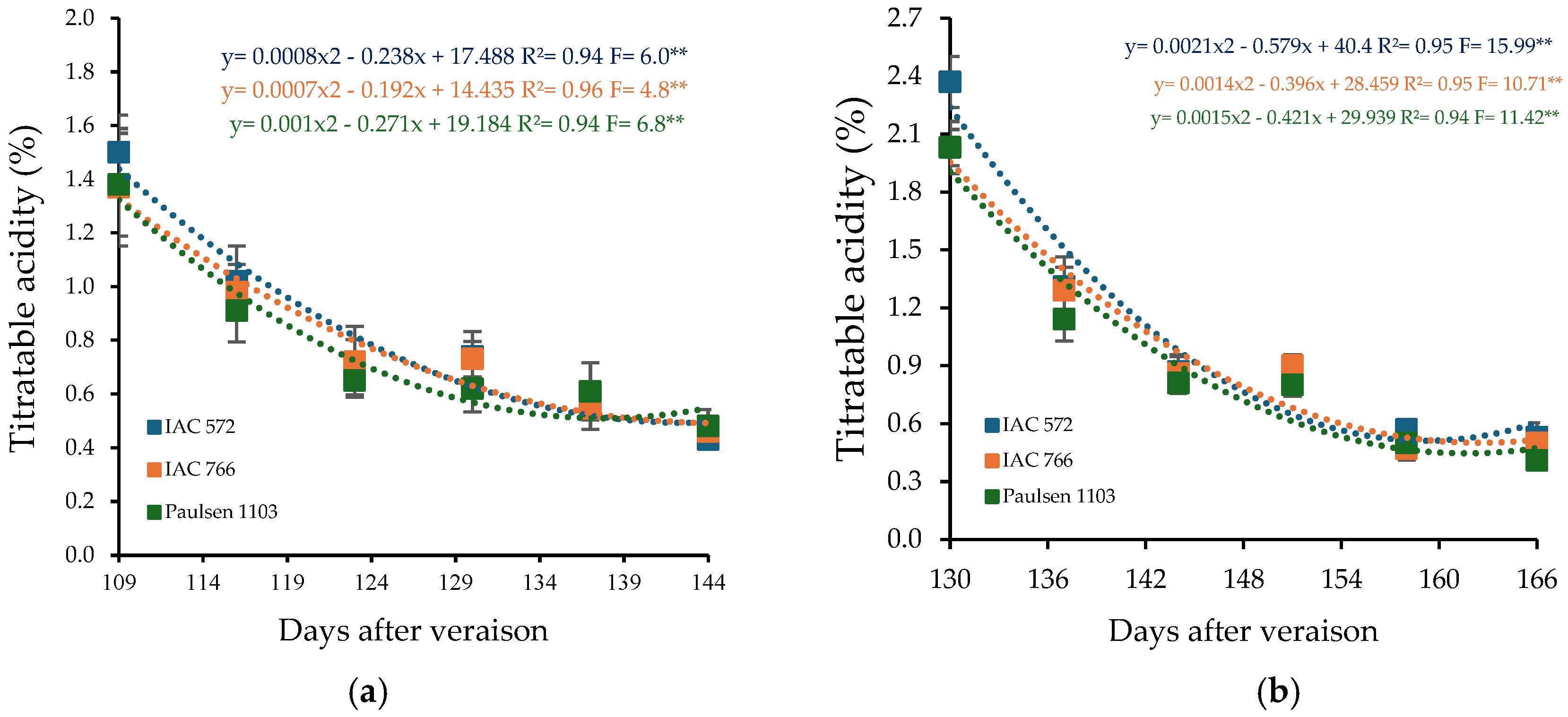

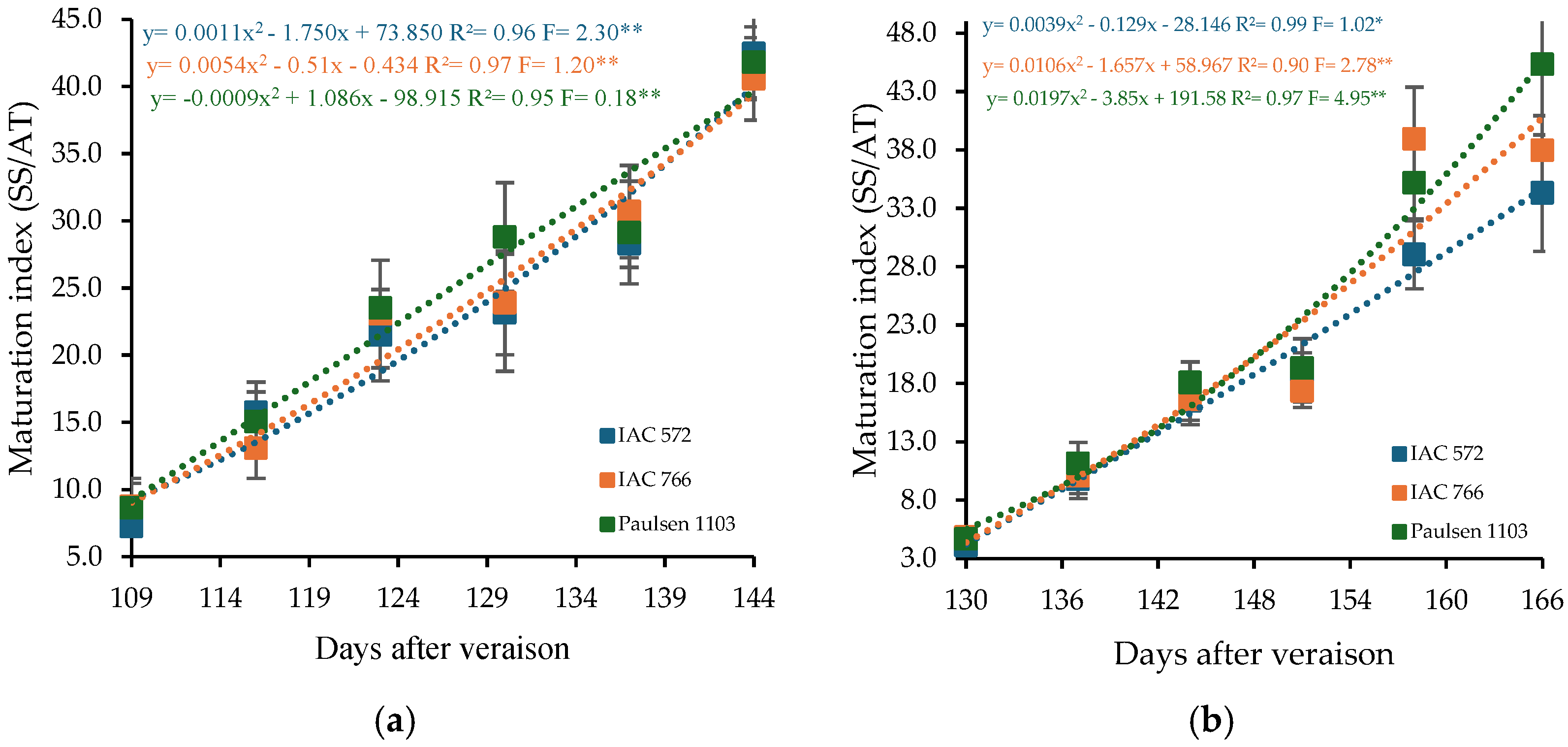
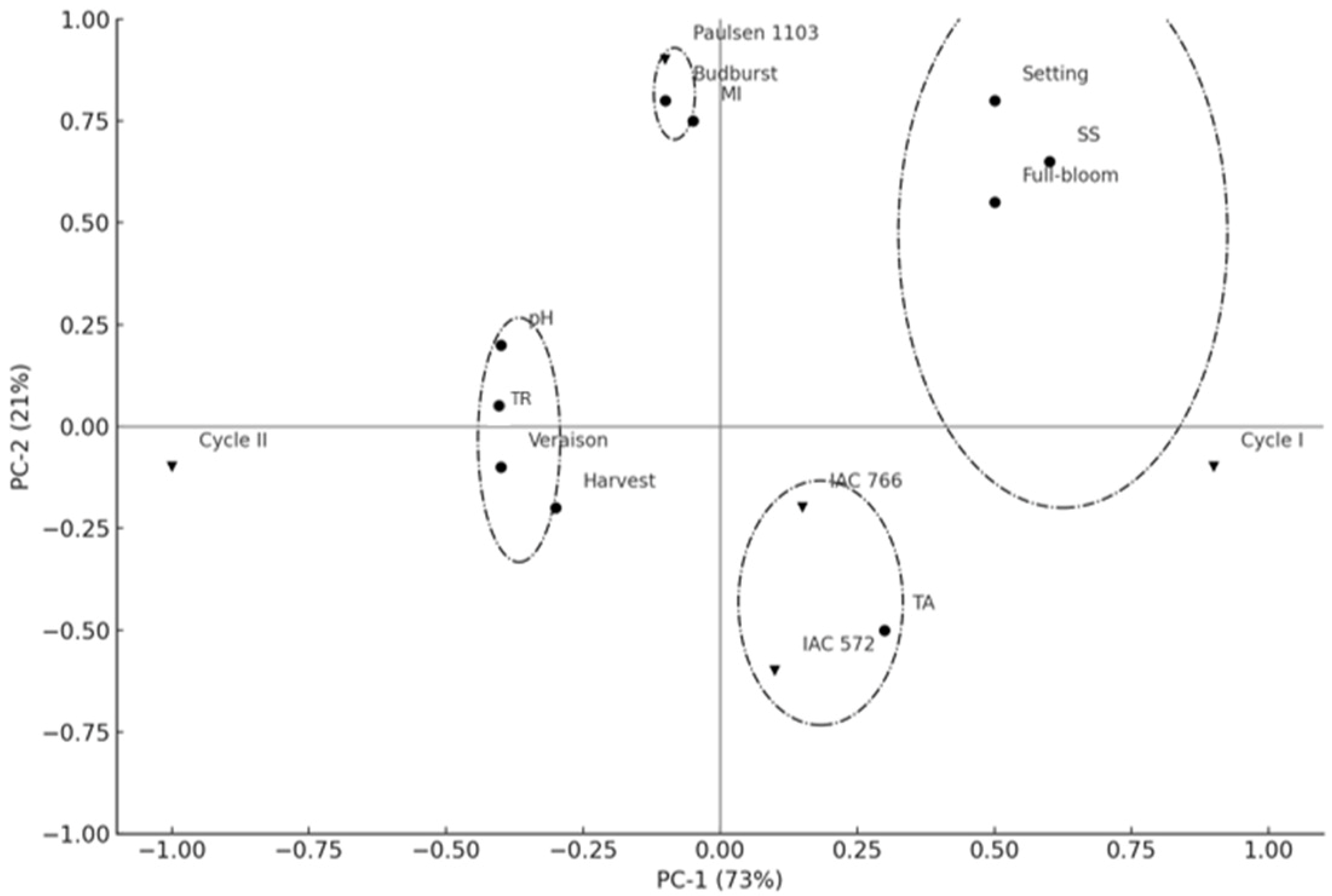
| Rootstocks | Duration of Phenological Stages (Days After Pruning) | |||||
|---|---|---|---|---|---|---|
| Budburst | Full-Bloom | Fruit Set | Veraison | Harvest | Thermal Requirement | |
| ‘IAC 766 Campinas’ | 19.3 ± 0.88 | 43.7 ±1.29 | 51.0 ± 1.29 | 115.8 ± 3.29 | 154.3 ± 3.29 | 1793.4 ± 51.9 |
| ‘IAC 572 Jales’ | 19.5 ± 1.67 | 44.5 ± 1.18 | 50.2 ± 0.70 | 116.2 ± 3.46 | 154.7 ± 3.46 | 1809.8 ± 50.2 |
| ‘Paulsen 1103’ | 20.3 ± 0.93 | 45.0 ± 1.29 | 51.2 ± 1.74 | 117.9 ± 1.48 | 156.4 ± 1.48 | 1819.4 ± 24.9 |
| CV (%) | 5.80 | 3.27 | 2.38 | 3.57 | 2.69 | 3.69 |
| DMS | 1.15 | 1.46 | 1.22 | 4.20 | 4.20 | 67.4 |
| Production cycle | Budburst | Full-bloom | Fruit set | Veraison | Harvest | Thermal Requirement |
| I | 19.7 ± 1.36 b | 46.5 ± 1.50 a | 51.4 ± 1.56 a | 106.6 ± 3.91 b | 142.6 ± 3.91 b | 1743.4 ± 53.1 b |
| II | 20.3 ± 1.16 a | 42.3 ± 1.03 b | 50.2 ± 0.97 b | 132.7 ± 4.53 a | 167.7 ± 4.53 a | 1871.7 ± 72.8 a |
| CV (%) | 6.76 | 2.58 | 2.19 | 2.70 | 2.03 | 2.83 |
| DMS | 0.86 | 0.74 | 0.72 | 2.04 | 2.04 | 33.1 |
Disclaimer/Publisher’s Note: The statements, opinions and data contained in all publications are solely those of the individual author(s) and contributor(s) and not of MDPI and/or the editor(s). MDPI and/or the editor(s) disclaim responsibility for any injury to people or property resulting from any ideas, methods, instructions or products referred to in the content. |
© 2025 by the authors. Licensee MDPI, Basel, Switzerland. This article is an open access article distributed under the terms and conditions of the Creative Commons Attribution (CC BY) license (https://creativecommons.org/licenses/by/4.0/).
Share and Cite
Monteiro, H.S.A.; Tecchio, M.A.; Brito, S.d.N.S.; Neto, F.J.D.; Sánchez, C.A.P.C.; Alonso, J.C.; Feliciano, D.E.F.; Maniero, C.R.; Cunha, P.H.H.; Silva, M.d.S. Phenological Development, Thermal Requirement, and Quality of ‘BRS Núbia’ (Vitis vinifera L. x Vitis labrusca L.) Grapes on Different Rootstocks. Horticulturae 2025, 11, 466. https://doi.org/10.3390/horticulturae11050466
Monteiro HSA, Tecchio MA, Brito SdNS, Neto FJD, Sánchez CAPC, Alonso JC, Feliciano DEF, Maniero CR, Cunha PHH, Silva MdS. Phenological Development, Thermal Requirement, and Quality of ‘BRS Núbia’ (Vitis vinifera L. x Vitis labrusca L.) Grapes on Different Rootstocks. Horticulturae. 2025; 11(5):466. https://doi.org/10.3390/horticulturae11050466
Chicago/Turabian StyleMonteiro, Harleson Sidney Almeida, Marco Antonio Tecchio, Sinara de Nazaré Santana Brito, Francisco José Domingues Neto, Camilo André Pereira Contreras Sánchez, Juan Carlos Alonso, Daví Eduardo Furno Feliciano, Carolina Ragoni Maniero, Pedro Henrique Hortolani Cunha, and Marcelo de Souza Silva. 2025. "Phenological Development, Thermal Requirement, and Quality of ‘BRS Núbia’ (Vitis vinifera L. x Vitis labrusca L.) Grapes on Different Rootstocks" Horticulturae 11, no. 5: 466. https://doi.org/10.3390/horticulturae11050466
APA StyleMonteiro, H. S. A., Tecchio, M. A., Brito, S. d. N. S., Neto, F. J. D., Sánchez, C. A. P. C., Alonso, J. C., Feliciano, D. E. F., Maniero, C. R., Cunha, P. H. H., & Silva, M. d. S. (2025). Phenological Development, Thermal Requirement, and Quality of ‘BRS Núbia’ (Vitis vinifera L. x Vitis labrusca L.) Grapes on Different Rootstocks. Horticulturae, 11(5), 466. https://doi.org/10.3390/horticulturae11050466







